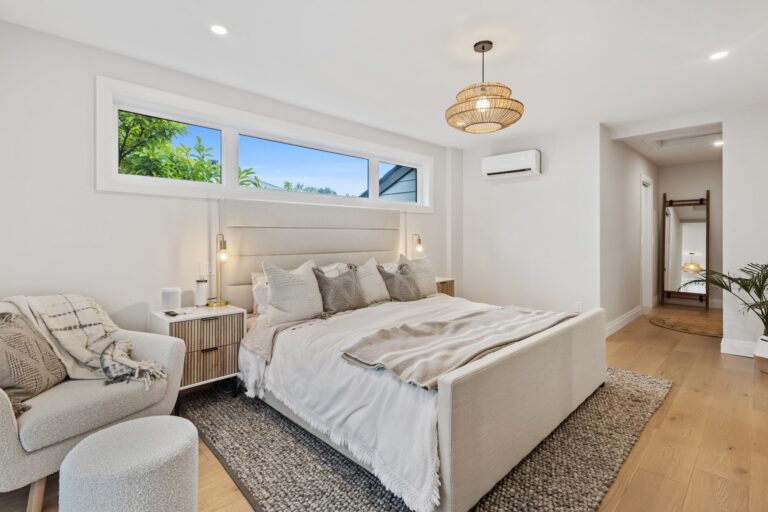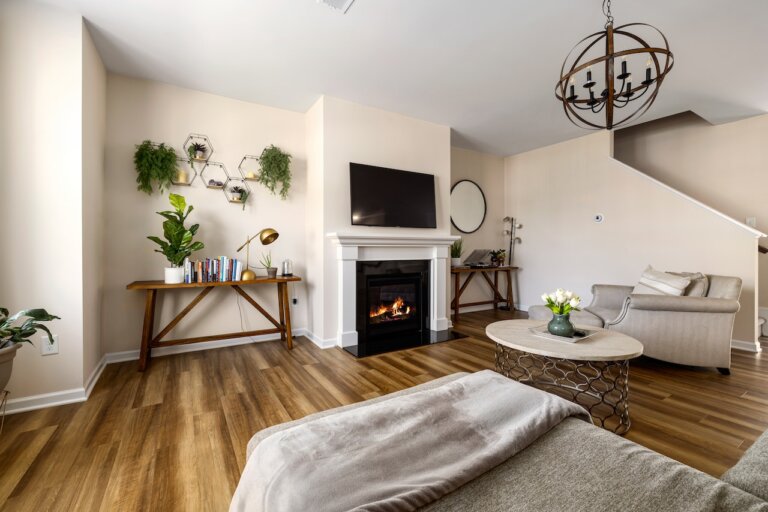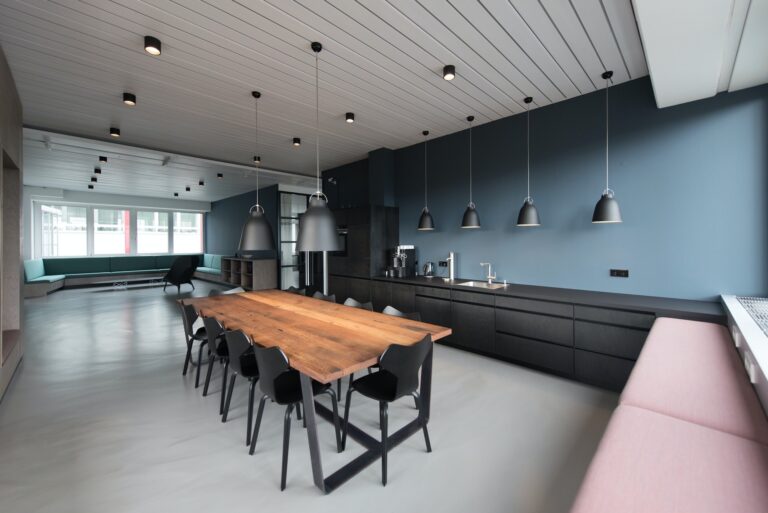Several aesthetic room themes have worked their way into bedroom decor in a big way, and keeping up with all the different types of bedroom styles can be daunting.
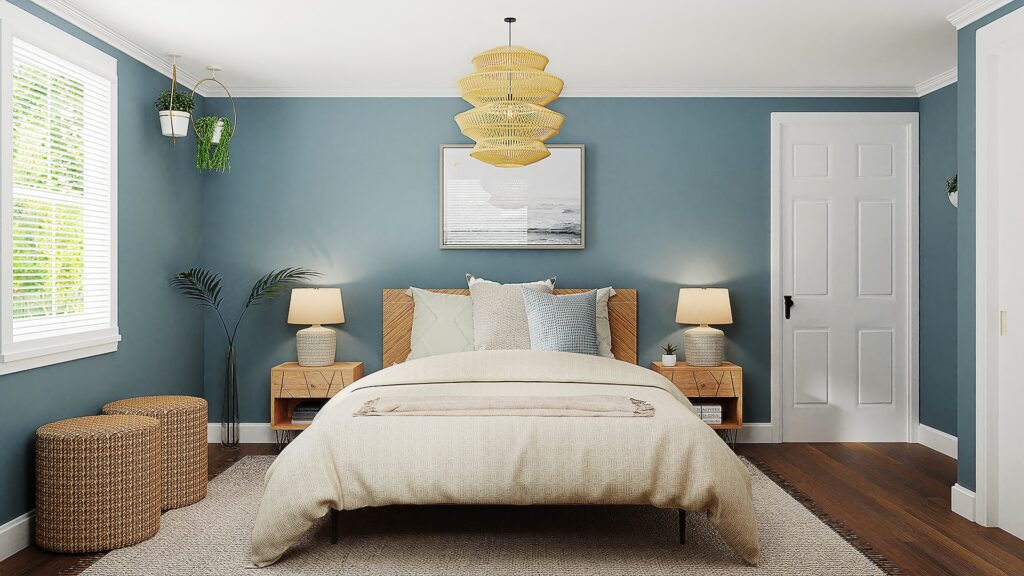
Everyone loves a comfortable, stylish space that reflects their personality. But you might find yourself asking, “What different types of room aesthetics are there?” or “Which one should I choose?”
If only there was a guide listing SEVERAL different types of room aesthetics you could scroll in your hand right now. That……..would be awesome.
Below I have created a list of 15 of the latest, most cozy trends for 2023. You want chic, cute, and trendy decor for your perfect bedroom theme? Of course you do!
Lets find the aesthetic that matches your awesome self!
What are Room Aesthetics Anyway?
Room aesthetics are all about how a room looks and feels. It’s about the colors, furniture, lighting, textures, patterns, and decorations that come together to make an inviting, cozy space. Well-designed room aesthetics have the power to set the desired mood and ambience of your space.

Lets go find the aesthetic vibe that speaks to you!
Types of Room Aesthetics
Here are 15 aesthetics to choose from, including characteristics and tips for achieving each look.
1. Minimalist Room Aesthetics
Minimalism is a popular room aesthetic characterized by simplicity, clean lines, and a focus on functionality. Minimalist rooms often feature a limited color palette, uncluttered spaces, and minimal decor.
The goal is to create a calm and serene environment that promotes clarity of mind and a sense of tranquility.
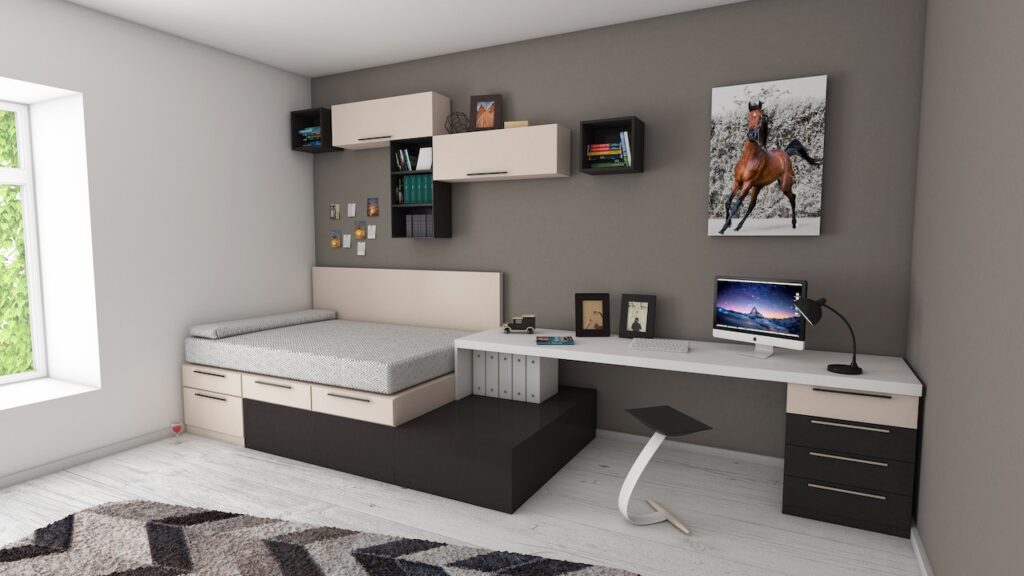
Characteristics of a Minimalist Room
- Simple and Clean Lines: Minimalist rooms often feature clean lines, both in the furniture and architectural design. Straightforward shapes and minimal ornamentation contribute to a sense of calm and order.
- Neutral Color Palette: A minimalist room typically employs a neutral color scheme, with shades of white, gray, and beige. These colors create a soothing atmosphere and allow the focus to be on the room’s form and function.
- Limited Decorative Pieces: In a minimalist room, decorative items are kept to a minimum. The emphasis is on functionality rather than excessive decor. Each piece serves a purpose, contributing to the overall aesthetic without overwhelming the space.
- Open and Airy Layout: Minimalist rooms often have an open and spacious layout, with plenty of natural light. This design choice enhances the feeling of simplicity and allows for better circulation and movement within the space.
- Decluttered and Organized: Clutter is the enemy of minimalist aesthetics. Minimalist rooms prioritize organization and tidiness, with ample storage solutions to keep belongings out of sight. This creates a sense of tranquility and promotes a clear mind.
2. Vintage Room Aesthetics
The vintage room aesthetic brings nostalgic charm, inspired by the 1920s, 1950s, and 1970s. With antique furniture, retro patterns, and faded colors, it creates a cozy, ‘simpler times’ atmosphere. Lets go antique shopping!

Characteristics of a Vintage Room
- Antique Furniture: Vintage rooms often feature antique furniture pieces as focal points. These treasures from the past add authenticity and a touch of history to your space. Look for ornate wooden tables, clawfoot chairs, and intricately carved armoires at flea markets or antique shops.
- Soft Color Palette: Vintage aesthetics are known for their soft, muted color schemes. Opt for gentle pastels such as dusty rose, mint green, or pale blue to create a serene and romantic ambiance. These colors work well on walls, upholstery, and accessories.
- Vintage Patterns: Incorporate vintage patterns into your room to enhance the nostalgic atmosphere. Floral prints, delicate lace, and traditional damask designs can be used on curtains, throw pillows, or even wallpaper. Mixing and matching patterns can add depth and character to your vintage-inspired space.
- Distressed Finishes: Embrace the beauty of imperfection by incorporating distressed finishes into your vintage room. Weathered paint on furniture, gently worn wooden floors, or chipped porcelain accents all contribute to the vintage charm. These small details create a sense of history and character in your space.
- Vintage room aesthetics encompass a range of eras, from the Victorian era to the mid-20th century. With the right eye for detail, you can create a captivating room that is both nostalgic and timeless. The beauty of vintage room aesthetics lies in their ability to transport us to a different time and evoke a sense of nostalgia.
3. Bohemian (Boho) Room Aesthetics
Bohemian aesthetics embrace a free-spirited and eclectic style. These rooms are characterized by vibrant colors, layered textures, and a mix of patterns.
Bohemian aesthetics often incorporate elements from different cultures, creating a unique and visually stimulating space that celebrates individuality and creativity.
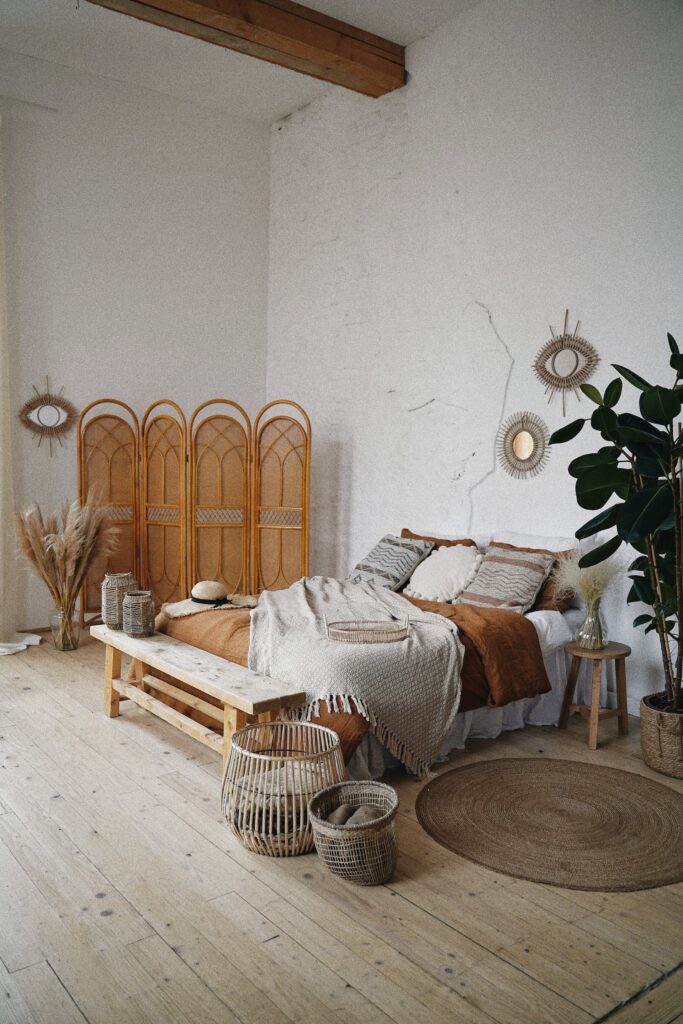
Characteristics of a Bohemian Room
- Mix of Patterns and Textures: One of the key characteristics of bohemian room aesthetics is the blend of various patterns and textures. Incorporating fabrics like tapestries, kilim rugs, and embroidered cushions can add depth and visual interest to your space.
- Vibrant Color Palette: Bohemian rooms often feature bold and vibrant colors such as deep reds, rich purples, and earthy greens. These hues can be incorporated through textiles, artwork, and accent pieces to create a lively atmosphere.
- Natural Elements: Bringing nature indoors is another hallmark of bohemian room aesthetics. Consider adding plants, dried flowers, or organic materials like rattan and jute to infuse a sense of organic beauty into your space.
- Global Influence: The bohemian style draws inspiration from various cultures around the world. Incorporating elements such as Moroccan lanterns, Indian tapestries, or African tribal prints can add an exotic touch to your room.
- Layered and Eclectic Decor: Bohemian rooms often showcase a layered and collected look. Don’t be afraid to mix and match different furniture styles, artwork, and accessories to create an eclectic and personalized space.
4. Scandinavian Room Aesthetics
This popular interior design style originated in the Nordic countries, such as Sweden, Norway, Denmark, and Finland. Scandinavian aesthetics are renowned for their simplicity, functionality, and timeless elegance.
These rooms often feature neutral color palettes, natural materials, and a focus on clean lines. Scandinavian aesthetics prioritize light and space, creating an airy and inviting atmosphere that promotes a sense of calm and well-being. Now I want to move to Northern Europe.
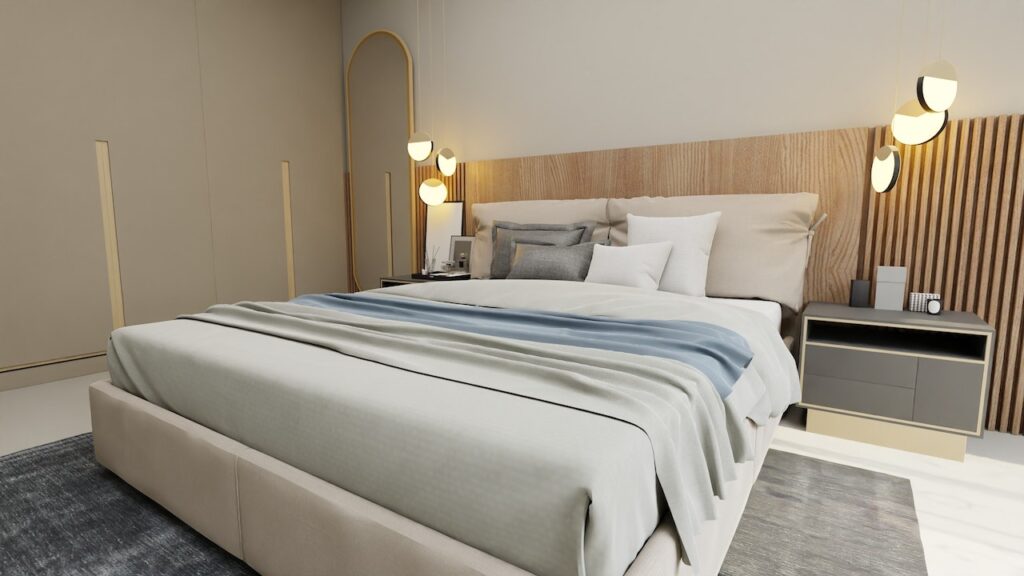
Characteristics of a Scandinavian Room
- Simplicity: Scandinavian design embraces simplicity in every aspect. It focuses on creating a clutter-free and streamlined space. Clean lines, uncluttered surfaces, and minimalistic furniture are integral to achieving this aesthetic.
- Neutral Color Palette: The color palette of Scandinavian room aesthetics typically revolves around soft and muted tones. Whites, creams, grays, and light pastels dominate the design, creating a serene and calming atmosphere. These colors also help to maximize natural light, which is essential in the Nordic region where sunlight can be limited.
- Natural Elements: Scandinavian design strongly emphasizes the use of natural materials, bringing a sense of warmth and coziness into the space. Wood, particularly light-colored woods like pine and birch, is commonly used in furniture and flooring. Other natural elements, such as stone and leather, can also be incorporated to add texture and visual interest.
- Functionality: Scandinavian design prioritizes functionality without sacrificing aesthetics. Furniture pieces are often multifunctional, providing storage solutions and practicality. Minimalistic yet comfortable seating and ergonomic designs are common in Scandinavian interiors.
- Hygge: Hygge, a Danish concept that represents coziness and contentment, is an integral part of Scandinavian room aesthetics. For instance, incorporating soft textiles, such as wool and fur, along with cozy throws and cushions, creates a warm and inviting atmosphere.
5. Industrial Room Aesthetics
Industrial aesthetics draw inspiration from raw and unfinished elements. Exposed brick walls, concrete floors, metal accents, and salvaged materials are common features in industrial rooms.
The goal is to create a sense of urban sophistication and edginess, often incorporating vintage and repurposed items. The ‘don’t throw that away I was going to do something with it’ look.
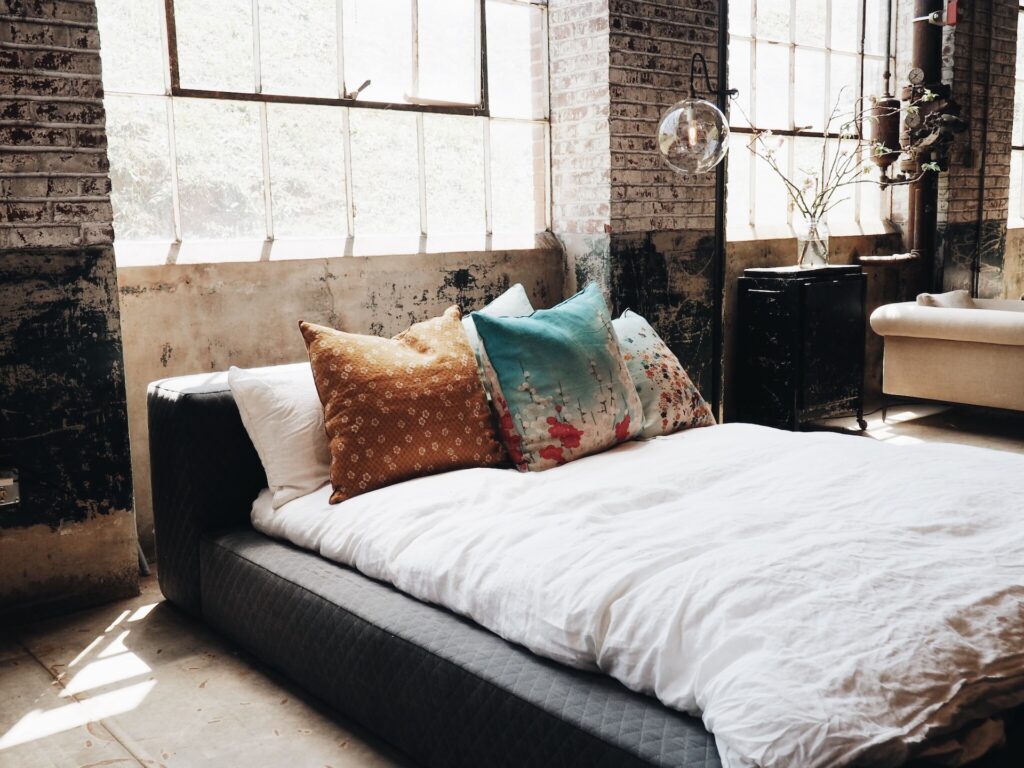
Characteristics of an Industrial Room
- Raw Materials: Industrial room aesthetics celebrate the beauty of unfinished materials such as exposed brick walls, concrete floors, and metal fixtures. These elements add a sense of authenticity and ruggedness to the space.
- Neutral Color Palette: The color scheme in industrial rooms often revolves around neutral tones like shades of gray, brown, and black. These colors enhance the industrial vibe and create a soothing atmosphere.
- Open Floor Plans: Industrial design favors open layouts that allow for seamless movement and flow throughout the space. By eliminating unnecessary partitions, industrial rooms feel spacious and uncluttered.
- Minimalist Furnishings: Industrial room aesthetics call for minimalist furniture pieces with clean lines and simple designs. Opt for furniture made of metal, wood, or leather to maintain the industrial theme.
- Exposed Architectural Elements: Embrace exposed beams, ductwork, and pipes to highlight the industrial charm of the space. These architectural elements add visual interest and serve as a reminder of the building’s history.
- Industrial Lighting: Industrial-style lighting fixtures, such as pendant lights or exposed bulb fixtures, are a key element in achieving the desired aesthetic. These fixtures not only provide adequate lighting but also contribute to the overall industrial vibe.
6. Coastal Room Aesthetics
Coastal aesthetics are inspired by the beach and ocean, creating a relaxing and refreshing atmosphere. Light and breezy color palettes, natural materials like rattan and driftwood, and nautical elements such as stripes and seashells are typical in coastal rooms.
The aim is to evoke a sense of tranquility and vacation-like vibe. Bermuda, Bahama, Come on Pretty Momma.
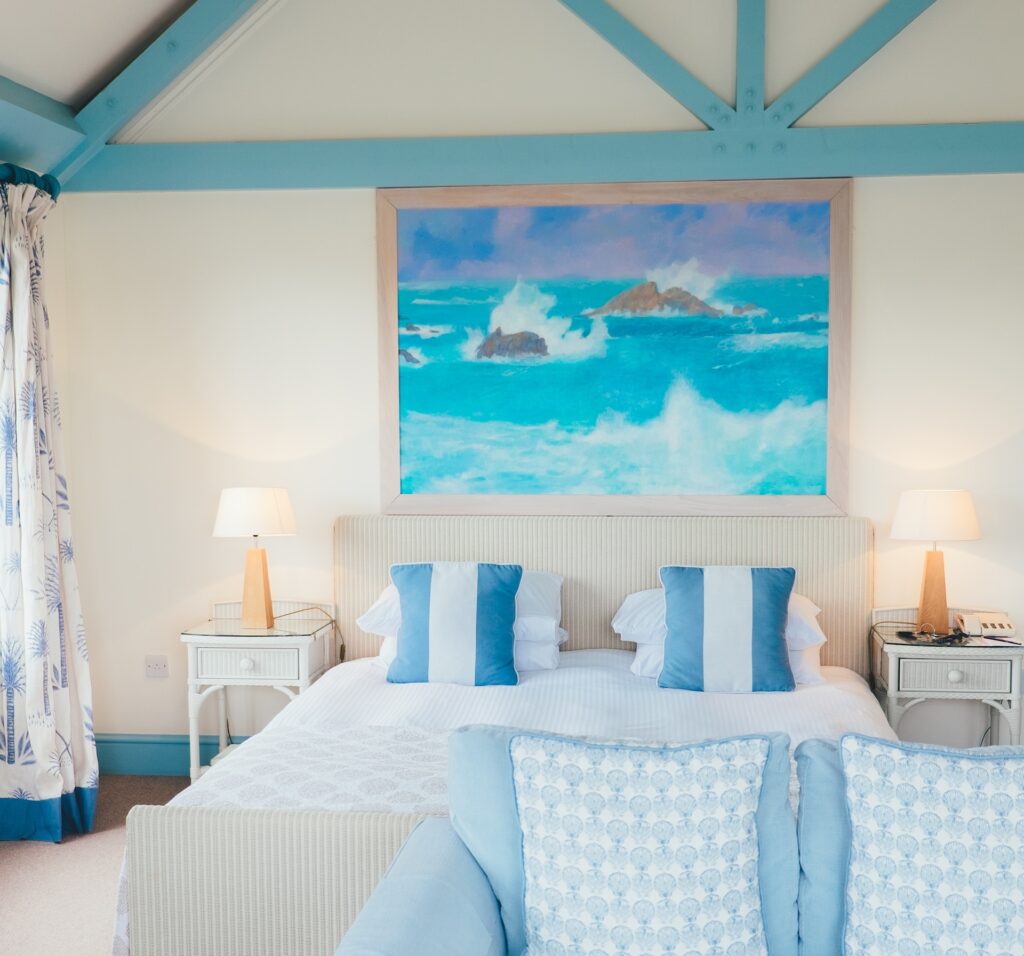
Characteristics of a Coastal Room
- Vacation-like aesthetics: light and breezy feel, reminiscent of a day at the beach.
- Color palette: soft hues, including various shades of blue, white, and sandy neutrals. These colors evoke a sense of calmness and serenity, mirroring the ocean waves and the sandy shoreline.
- Natural materials: Elements like weathered wood, rattan, and wicker add a touch of organic warmth and texture. Incorporating these materials into furniture pieces, such as a rattan armchair or a reclaimed wood coffee table, can instantly transform your space into a coastal retreat.
- Nautical elements: Seashells, starfish, and driftwood can be used as decorative accents, while maritime-inspired artwork or vintage maps can be displayed on the walls. These small touches will transport you to the seaside and create a cohesive coastal look.
7. Indie Room Aesthetics
Indie aesthetics are about being unique and original. It’s a creative style that rejects mainstream norms and embraces individuality. It can be seen in indie music, films, and fashion.
Indie themes celebrate imperfections and value authenticity. (Think unique over mass-produced) They capture the essence of creative freedom and the desire to stand out.
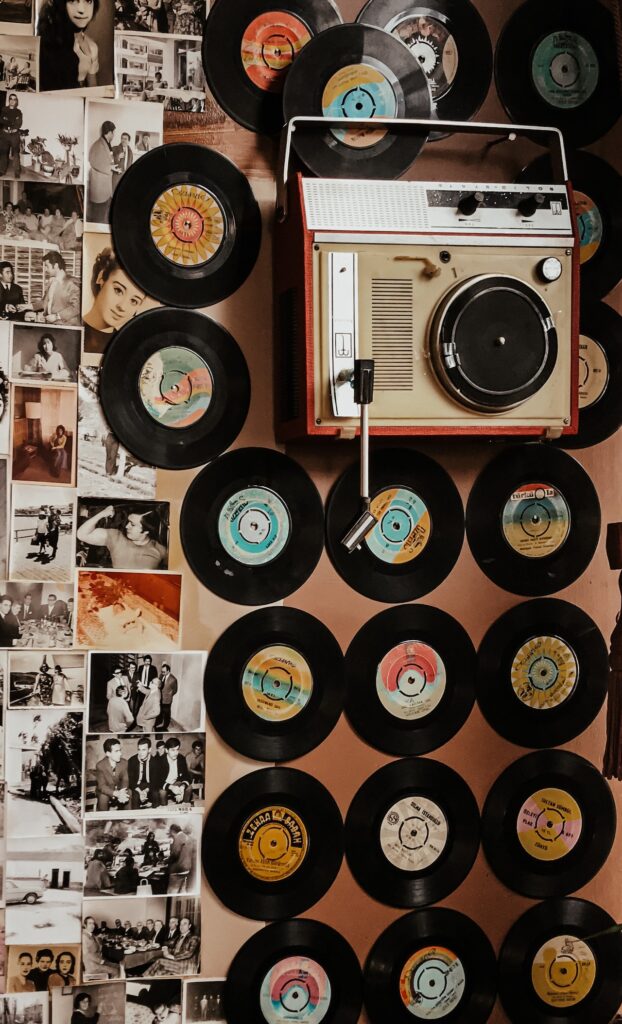
Characteristics of an Indie Room
- Vintage Treasures: Indie room aesthetics often incorporate vintage elements like retro furniture, thrifted finds, and antique decor. These items add a sense of history and character to the space, creating a cozy and nostalgic atmosphere.
- Bohemian Flair: Embracing a bohemian influence is another key characteristic of indie room aesthetics. Incorporate textiles, such as macramé wall hangings, woven rugs, and vibrant tapestries, to infuse your space with warmth and texture.
- Artistic Touches: Indie rooms are known for their artistic flair. Display your favorite artwork, whether it’s paintings, prints, or photographs, to add a personal touch and showcase your unique taste and interests.
- Mix and Match: One of the hallmarks of indie room aesthetics is the ability to mix different styles and eras. Don’t be afraid to combine vintage and modern elements, blending contrasting textures and patterns to create an effortlessly curated look.
8. Cottagecore Room Aesthetics
Cottagecore room aesthetic is a cozy countryside cottage style. It has wooden furniture, vintage decor, and floral patterns. The colors are soft and earthy, like cream, sage green, and dusty rose. Add knitted blankets and lace curtains for a cozy vibe. It brings tranquility and simplicity to your space. What kind of psycho doesn’t want to live in a cozy cottage?
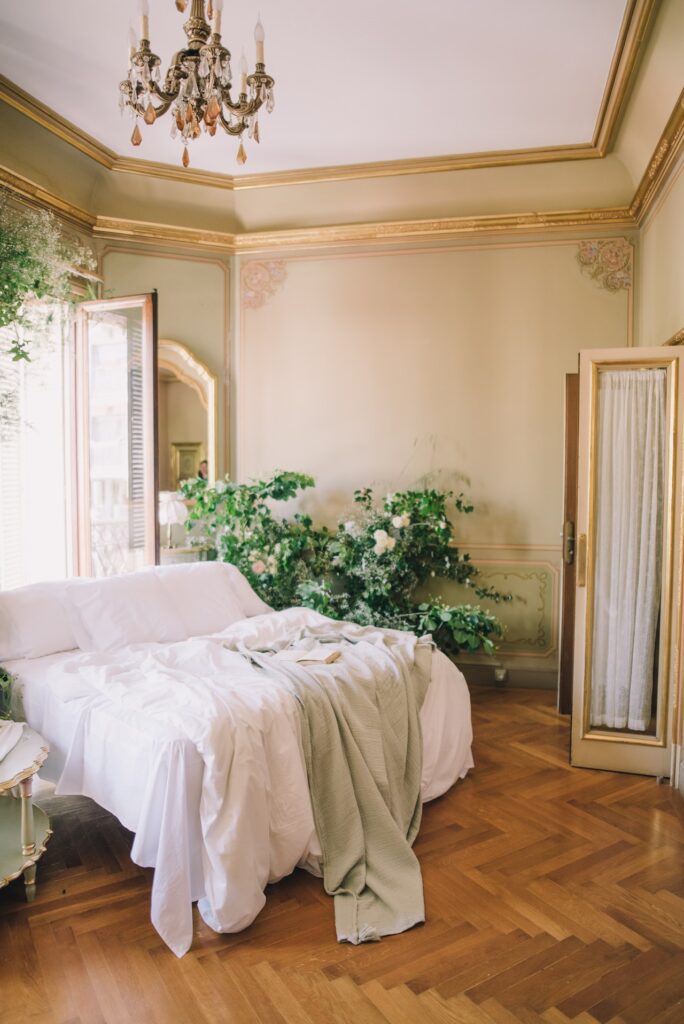
Characteristics of a Cottagecore Room
- Natural Elements: Cottagecore room aesthetics often incorporate natural elements such as wood, stone, and plants. Wooden furniture and accents can add warmth and rustic charm to your space, while stone elements can create a sense of grounding. Including an abundance of plants, both real and artificial, can bring life and freshness to your room.
- Soft and Earthy Colors: The color palette of cottagecore room aesthetics is typically soft and earthy, with hues inspired by nature. Think muted greens, warm browns, soft yellows, and delicate pastels. These colors create a serene and soothing atmosphere, reminiscent of a countryside cottage.
- Vintage and Antique Pieces: Embracing the cottagecore aesthetic often means incorporating vintage or antique furniture and decor items into your room. Scour flea markets or thrift stores for unique pieces that add character and a touch of nostalgia to your space. Vintage floral prints, lace curtains, and delicate porcelain are all excellent choices.
- Textures and Patterns: Adding texture and patterns can enhance the cottagecore aesthetic. Consider using floral or gingham patterns for your curtains, bedding, or upholstery. Layering cozy blankets and cushions with different textures, such as knits or quilts, can add depth and warmth to your room.
9. Coquette Room Aesthetics
Create a flirty and chic room with a coquette vibe. Use gentle fabrics, soft colors, and dainty accessories for a charming and playful look. Pick vintage-style furniture with fancy curves and intricate details. Add a feminine touch with floral patterns, lace accents, and frilly curtains. Fancy Nancy all grown up!
This romantic and whimsical ambiance is perfect for those who love charm and allure. Ooh la la.

Characteristics of a Coquette Room
- Soft Color Palette: Coquette room aesthetics often feature soft and delicate hues such as blush pink, pastel blue, lavender, or mint green. These colors create a dreamy ambiance and add a feminine touch to the space.
- Elegant Furniture: To achieve the coquette style, opt for furniture pieces that showcase elegance and grace. Think curvaceous silhouettes, delicate details, and a touch of glamour. Vintage-inspired furniture or pieces with intricate carvings can work wonders in creating the desired aesthetic.
- Luxurious Fabrics: Coquette room aesthetics call for luxurious fabrics that enhance the overall allure of the space. Incorporate velvet, silk, lace, or satin textures through curtains, upholstery, throw pillows, or bedding. These fabrics help to bring in the fancy vibe!
- Playful Accents: To infuse a touch of whimsy into the space, incorporate playful accents. Decorative elements like fringes, tassels, bows, or floral patterns can instantly uplift the coquette aesthetic. Consider adding these details through rugs, cushions, curtains, or wallpaper.
- Romantic Lighting: Lighting plays a crucial role in setting the mood for a coquette room. Opt for soft, warm lighting options such as chandeliers, pendant lights, or table lamps with delicate lampshades. Soft, diffused lighting creates a romantic ambiance and enhances the overall allure of the space. Oui oui!
10. Danish Pastel Room Aesthetics
The Danish pastel room aesthetic is all about soft, muted colors (similar to Scandinavian but more pastel colors and feminine feel). Think blush pink, mint green, and baby blue. This style is minimalist, with clean lines and natural materials. It creates a calm and peaceful space that promotes relaxation and harmony. What else would you expect from the culture that brought you Hygge?
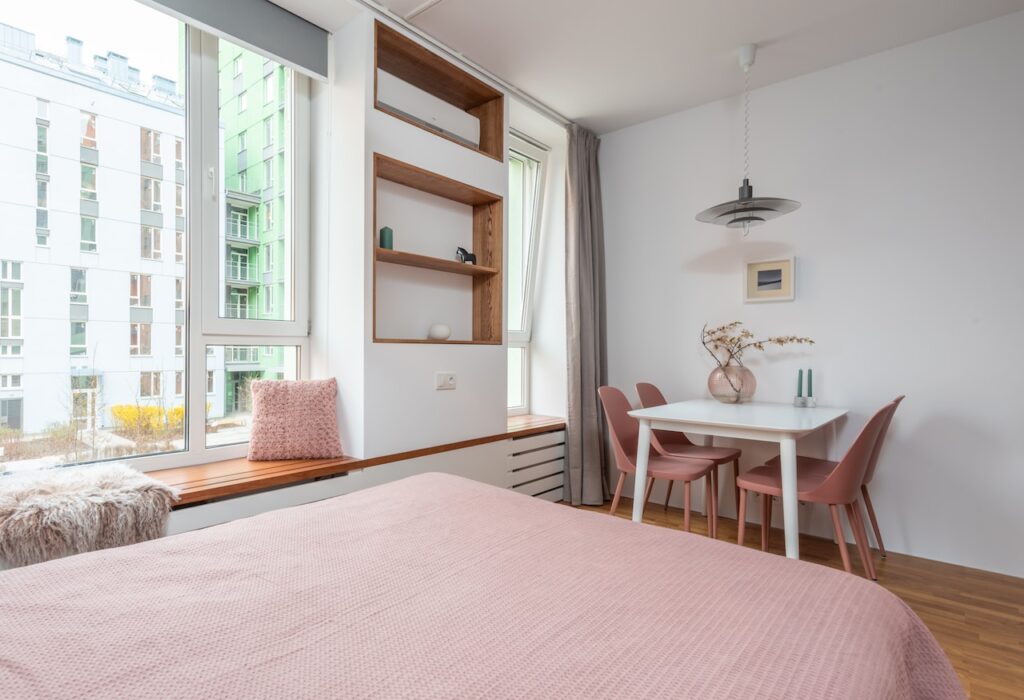
Characteristics of a Danish Pastel Room
- Soft Color Palette: Danish pastel room aesthetics are characterized by a gentle and muted color scheme. Think soft pastel shades such as blush pink, baby blue, mint green, and light gray. These soothing hues create a calm and inviting atmosphere in any space.
- Clean Lines and Minimalism: Simplicity is at the heart of Danish pastel room aesthetics. Clean lines and minimalistic furniture choices help create an uncluttered and airy feel. Opt for sleek, streamlined furniture pieces and minimalistic decor items to achieve this look.
- Natural Materials: Danish design embraces the use of natural materials, and this principle extends to Danish pastel room aesthetics as well. Incorporating materials like light-colored wood, rattan, and linen adds warmth and texture to the space, enhancing the overall cozy ambiance.
- Functionality: Danish design is renowned for its focus on functionality, and this holds true for Danish pastel room aesthetics too. Furniture pieces often serve multiple purposes and boast smart storage solutions. This allows you to maintain a clean and organized space while maximizing functionality.
- Let in Natural Light: Danish pastel room aesthetics thrive in natural light. Keep your windows uncovered or opt for sheer curtains that allow sunlight to filter through. This not only brightens up the space but also enhances the softness of the pastel colors.
11. Preppy Room Aesthetics
The preppy room look mixes classy elements and vibrant pops of color, incorporating traditional patterns like stripes and plaids. Think sophisticated with a fun twist. The space has carefully chosen books, artwork, and keepsakes. It’s about creating a stylish and timeless atmosphere that’s cozy and visually pleasing.
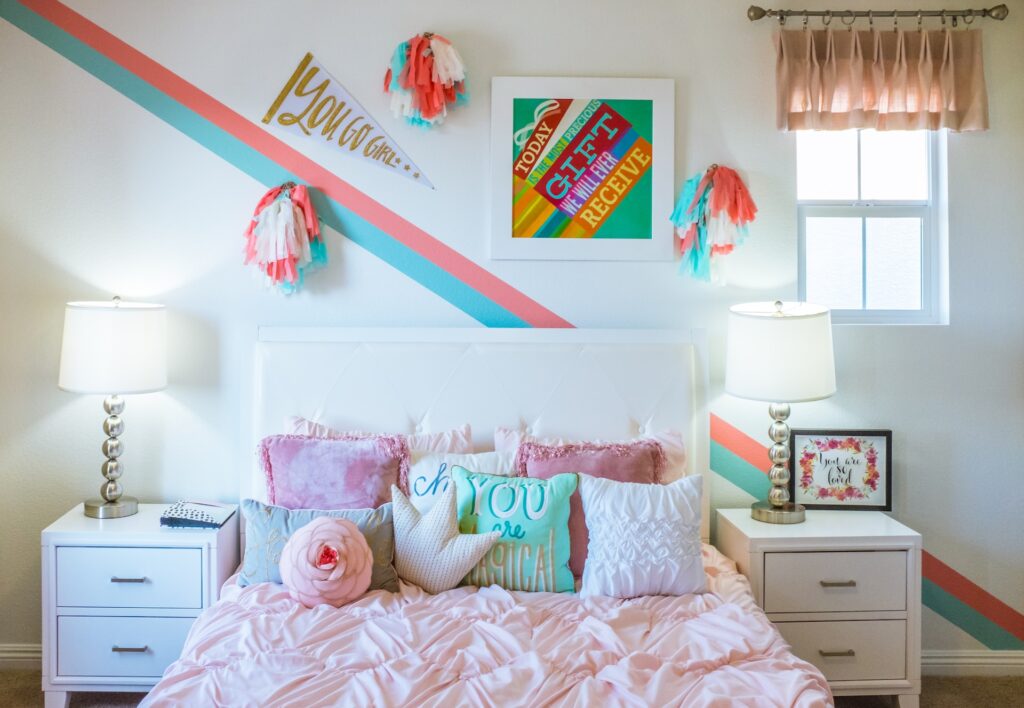
Characteristics of a Preppy Room
- Color Palette: Preppy room aesthetics often feature a vibrant and cheerful color palette. Think of classic combinations like navy and white, pink and green, or bold stripes and plaids. These colors bring a sense of energy and playfulness to the space while maintaining a sense of elegance.
- Patterns and Textures: Incorporate patterns and textures that are synonymous with preppy style. Look for items adorned with polka dots, gingham, houndstooth, or even a timeless floral print. Adding texture through fabrics like linen, tweed, or seersucker can also enhance the preppy vibe.
- Furniture and Accessories: Opt for furniture pieces that have a refined and classic appeal. Think of pieces with clean lines, such as a tufted headboard, a vintage-inspired desk, or a traditional wingback chair. Accessories like monogrammed pillows, brass accents, and framed artwork can further elevate the preppy aesthetic.
- Nautical Touches: Preppy style often draws inspiration from the seaside, so incorporating nautical elements can enhance the overall look. Consider adding anchors, ropes, or sailboat motifs in subtle ways, such as through artwork or decorative pieces.
- Organization and Neatness: Preppy room aesthetics embrace tidiness and organization. Invest in storage solutions that are both functional and visually appealing, like wicker baskets or decorative boxes. Keep your space clutter-free to maintain the elegant and polished feel.
12. Grunge Room Aesthetics
The grunge room aesthetic is a style that mixes alternative, punk, and vintage. It’s all about being edgy and rebellious with dark colors, distressed textures, and a nonconformist attitude.
Think torn band posters, old records, and worn-out furniture. It’s a unique way to express yourself and immerse in a world of attitude and authenticity.
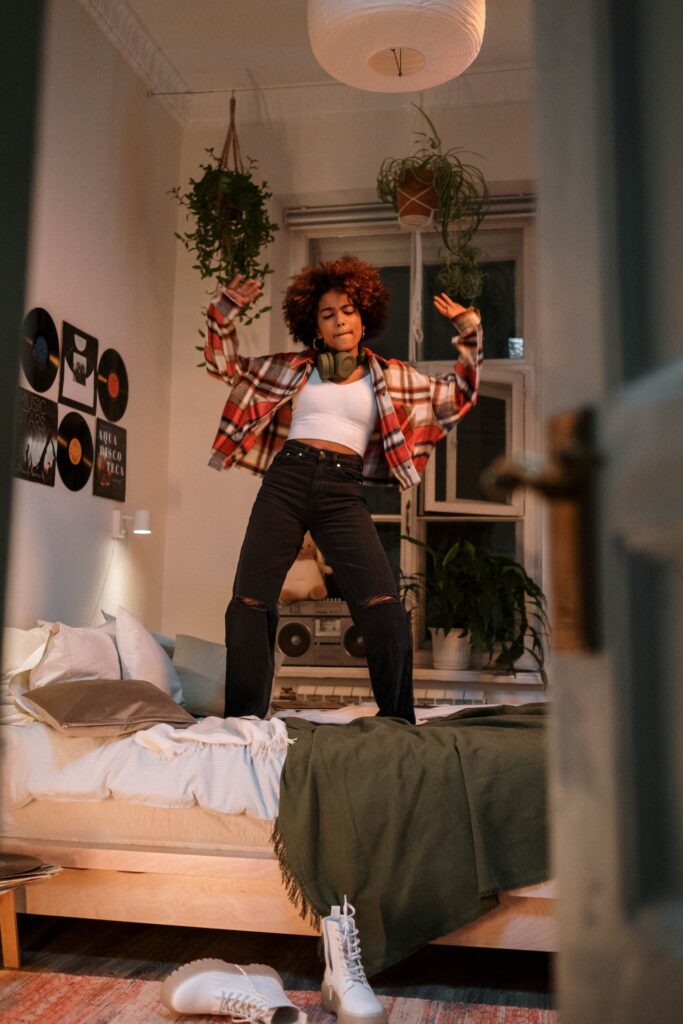
Characteristics of a Grunge Room
- Raw and Distressed Elements: Grunge rooms often feature exposed brick walls, weathered wooden floors, or peeling paint, adding a raw and distressed look to the space. These elements create a sense of authenticity and evoke a lived-in feel.
- Dark Color Palette: Typically, grunge rooms embrace a darker color palette, with shades such as deep charcoal, rich burgundy, and midnight blues. These colors help create a moody atmosphere and provide a stark contrast to any lighter accent pieces.
- Eclectic Furnishings: Grunge room aesthetics thrive on a mix of vintage, thrifted, and unconventional furniture pieces. Think mismatched chairs, distressed leather sofas, or repurposed items like wooden crates transformed into shelves. This eclectic approach adds character and an element of surprise to the overall design.
- Industrial Touches: Incorporating industrial elements, such as metal fixtures, exposed pipes, or vintage light fixtures, can enhance the grunge aesthetic. These details provide an urban and slightly gritty vibe, reinforcing the rebellious nature of the style.
- Textured Fabrics: Grunge rooms often feature textured fabrics like faux fur, distressed leather, or chunky knit throws. These fabrics add depth and tactile interest to the space, contributing to the cozy and inviting atmosphere.
13. Y2K Room Aesthetics
The Y2K room aesthetic combines futuristic and nostalgic vibes, capturing the vibrant style of 2000-2009. It features bright colors, flashy patterns, and nods to pop culture like movies, music, and video games from that era.
The goal is to create a fun and energetic space that brings back memories or sparks curiosity, reminiscent of the turn of the millennium.
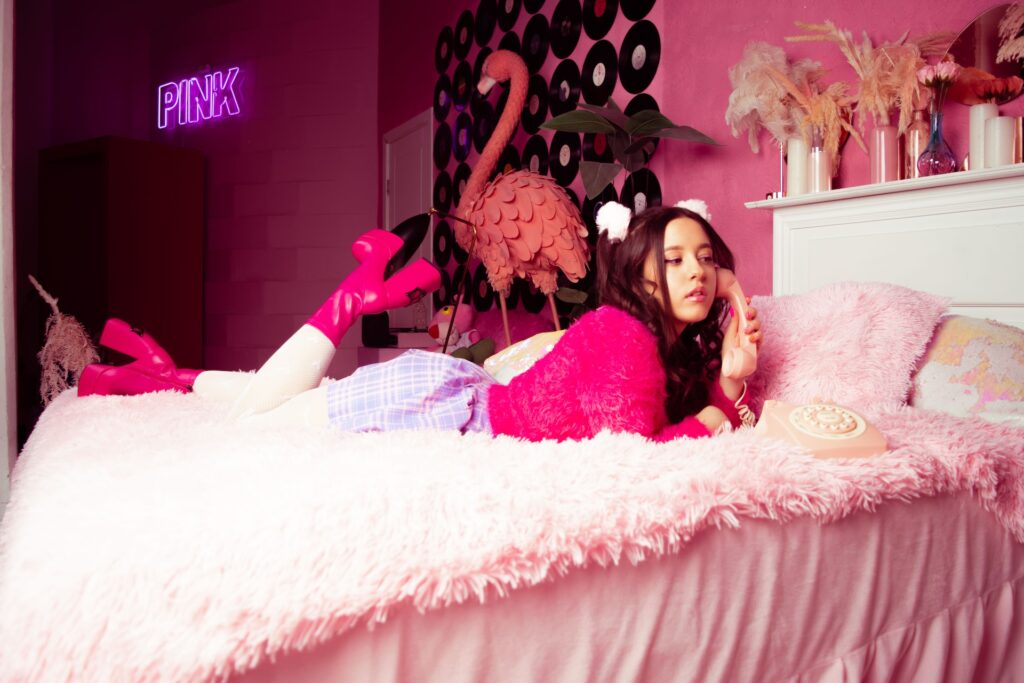
Characteristics of a Y2K Room
- Bold Colors and Patterns: Y2K room aesthetics embrace bold and vibrant color schemes, often incorporating neon and metallic shades. Think bright pinks, electric blues, and shimmering silver accents. Patterns such as geometric shapes and abstract designs are also common.
- Retro Futurism: One of the defining features of Y2K room aesthetics is the fusion of retro and futuristic elements. It combines the sleek lines and minimalist designs of the future with the nostalgia of the past. This juxtaposition creates a visually striking and nostalgic atmosphere.
- Tech-Inspired Decor: Y2K aesthetics draw inspiration from the rapid advancement of technology during that era. Incorporate tech-inspired decor such as sleek computers, funky-shaped televisions, and futuristic lighting fixtures. Think along the lines of bubble chairs, lava lamps, and robotic-themed accessories.
- Pop Culture Influences: Y2K room aesthetics often incorporate references to popular culture from that time. This could include movie posters, music album covers, or even iconic toys and games. Incorporating these elements adds a touch of nostalgia and personality to the space.
- Mix of Materials: Y2K aesthetics embrace a mix of materials to create an eclectic yet cohesive look. Combining glossy surfaces, metallic finishes, plastic accents, and even reflective materials can help capture the futuristic essence of the era.
14. Fairycore Room Aesthetics
Fairycore room aesthetic brings enchantment and whimsy with soft pastel colors, floral patterns, and twinkling lights. Decorations like fairy wings, floral garlands, and dreamcatchers add a mystical touch. Likewise, natural elements such as plants, crystals, and rustic wooden furniture create an earthy feel.

Characteristics of a Fairycore Room
- Soft Color Palette: Fairycore room aesthetics are characterized by a soft and muted color palette. Think pastel shades of lavender, blush pink, mint green, and baby blue. These colors evoke a sense of calmness and serenity, reminiscent of a fairytale setting.
- Natural Elements: Incorporating natural elements is key to achieving fairycore room aesthetics. Use materials like wood, rattan, and wicker to bring a touch of nature into your space. You can also include floral patterns, dried flowers, and lush greenery to add an organic feel.
- Vintage Touches: Fairycore aesthetics often embrace vintage and antique elements. Look for vintage furniture pieces, such as ornate mirrors or delicate lace curtains, to create a nostalgic atmosphere. Incorporate vintage-inspired accessories like old books, vintage-inspired artwork, and antique trinkets to enhance the enchanting vibe.
- Soft Lighting: Lighting plays a crucial role in creating a magical ambiance. Opt for soft, warm lighting with fairy lights or string lights to add a whimsical touch to your space. You can also use candles or lanterns to create a cozy and mystical atmosphere.
- Delicate Textiles: Fairycore room aesthetics are all about softness and comfort. Choose fabrics like lace, chiffon, or velvet for curtains, bedding, and pillows. These delicate textiles add a romantic and ethereal feel to the room.
15. Modern Room Aesthetics
The modern room aesthetic is all about sleek and minimal design. It loves clean lines, simplicity, and functionality. It utilizes open spaces, neutral colors, and natural light. Modern rooms have furniture and decor that serve a purpose and add elegance. It’s perfect for those who want a clean and uncluttered look in their living spaces.
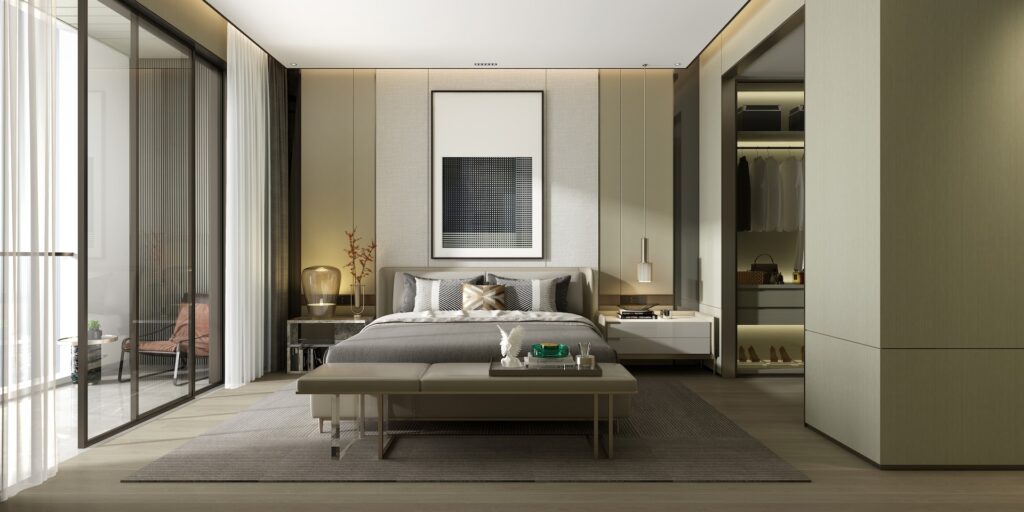
Characteristics of a Modern Room
- Minimalism: One of the key characteristics of modern room aesthetics is minimalism. This means decluttering your space and keeping only the essential items. Embrace clean lines, open spaces, and a lack of excessive ornamentation.
- Neutral Color Palette: Modern room aesthetics often feature a neutral color palette, including shades of white, gray, and beige. These colors create a sense of calmness and help to enhance the clean and uncluttered look of the room. Consider adding pops of color through accessories or artwork to add visual interest.
- Sleek and Simple Furniture: Furniture in a modern room should be sleek and simple in design. Opt for pieces with clean lines and avoid ornate details. Choose furniture with a minimalist aesthetic and prioritize functionality over decorative elements.
- Natural Light and Open Spaces: Modern room aesthetics often emphasize the use of natural light. Allow as much natural light as possible into the room by using sheer curtains or blinds that can be easily opened. Additionally, create open spaces that flow seamlessly from one area to another, promoting a sense of spaciousness.
- Use of Technology: Integrating technology into your modern room can enhance its overall aesthetic. Consider incorporating smart home devices, such as voice-controlled lighting systems or automated window shades, to add convenience and a touch of modernity.
16. Farmhouse Room Aesthetic
Farmhouse room aesthetic blends rustic charm with cozy comfort. Think reclaimed wood beams, shiplap walls, and soft neutral palettes accented with vintage decor. It’s all about mixing the old with the new—antique furniture paired with modern fixtures, metal accents juxtaposed with fluffy throws, and a touch of greenery to bring life and warmth. Every detail feels thoughtfully curated, making the room a perfect escape from the hustle and bustle of everyday life.
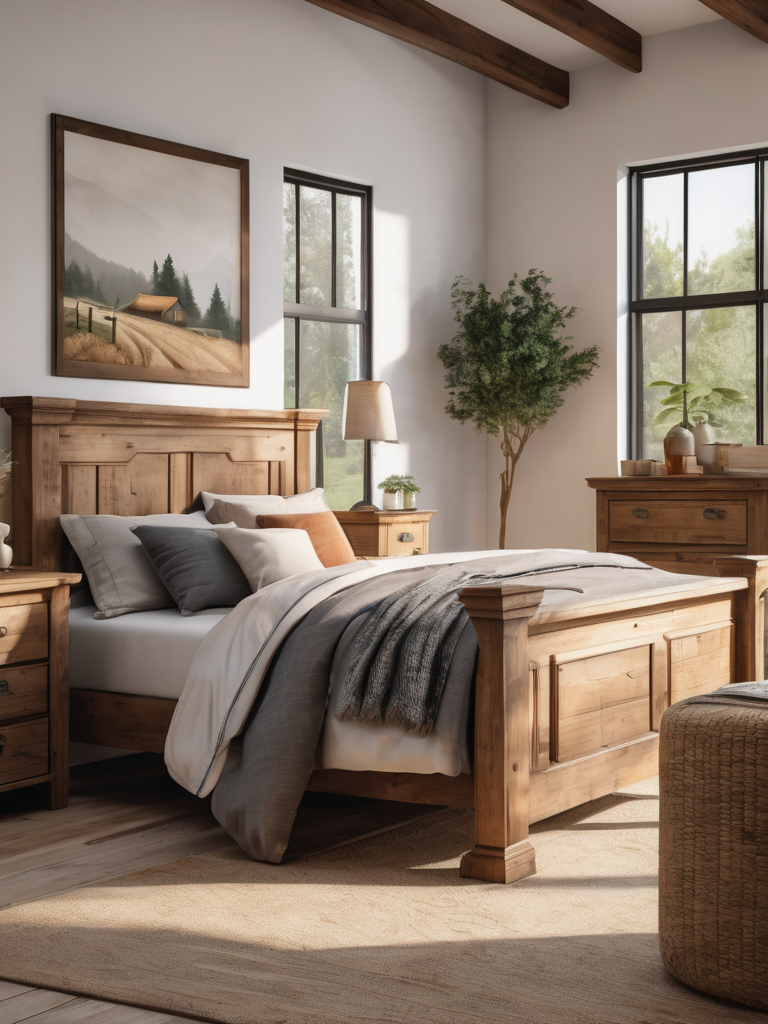
Characteristics of a Farmhouse Room
- Natural Light: Farmhouse bedrooms are often drenched in natural light. Large windows, sometimes with simple, white curtains, allow sunlight to flood the room, creating a bright and airy feel. The abundance of natural light enhances the room’s cozy and welcoming ambiance.
- Neutral Color Palette: A farmhouse bedroom typically features a neutral color palette. Shades of white, beige, and gray dominate, providing a calm and soothing environment. These colors create a perfect backdrop for other rustic elements and allow them to stand out.
- Wood Elements: Wood is a staple in farmhouse design. From exposed ceiling beams to reclaimed wood furniture and hardwood floors, these elements bring warmth and texture to the bedroom. The natural grain and imperfections of the wood add character and charm.
- Vintage Furniture: Vintage or vintage-inspired furniture is a key feature. Items like a weathered dresser, an antique bed frame, or a distressed nightstand add a sense of history and nostalgia. These pieces often have a handcrafted look that contributes to the room’s overall aesthetic.
- Textured Fabrics: Textured fabrics play a significant role in a farmhouse bedroom. Think chunky knit throws, linen bedding, and burlap accents. These materials add depth and coziness, making the bedroom feel lived-in and comfortable.
- Simple Decor: Simplicity is at the heart of farmhouse decor. Decorations are often minimal, with carefully selected pieces that have both aesthetic and functional value. Think of a vintage clock, a simple vase with wildflowers, or a well-worn leather footstool.
- Shiplap Walls: Shiplap walls are synonymous with farmhouse style. These horizontal wooden boards add a rustic charm and texture to the walls. Often painted in white or soft hues, shiplap provides a subtle yet distinctive backdrop.
- Floral Patterns: Floral patterns are a common motif in farmhouse bedrooms. Whether it’s through bedding, wallpaper, or curtains, these patterns add a touch of femininity and elegance. They often feature soft, muted colors that blend seamlessly with the overall neutral palette.
- Iron Accents: Iron accents lend an industrial edge to the farmhouse aesthetic. Wrought iron bed frames, chandeliers, or curtain rods introduce a contrast that enhances the rustic vibe. These elements are sturdy and functional, adding to the room’s practical but stylish appeal.
- Handcrafted Details: Handcrafted details like woven baskets, knitted blankets, and handmade pottery bring a personal touch to the farmhouse bedroom. These items often carry stories and heritage, making the space uniquely yours.
Conclusion
With so many different types of bedroom styles, it can be easy to be overwhelmed by your options. I hope this guide helped you hone in on your perfect aesthetic. You deserve a space that gives you all the good tingles!
Need help creating your aesthetic once you’ve chosen the perfect theme?
How about help creating the perfect lighting for your bedroom’s new style?
Which bedroom aesthetic did you end up choosing? Any different types of bedroom themes you’d like me to add? You can let me know in the comments below!
Until next time, stay cozy my friends.
